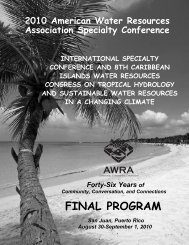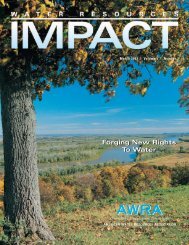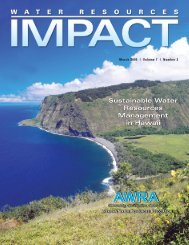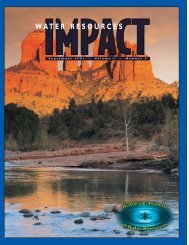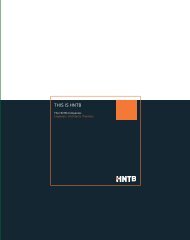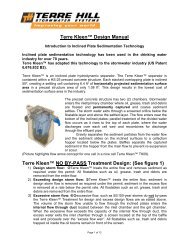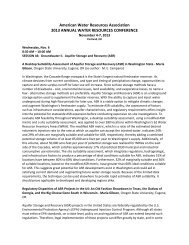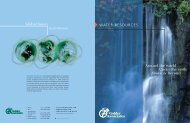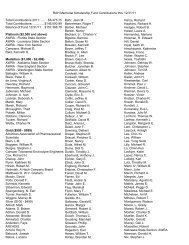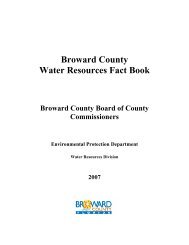Impacts of Tile Drains on Flood Mitigation Ecosystem Services ...
Impacts of Tile Drains on Flood Mitigation Ecosystem Services ...
Impacts of Tile Drains on Flood Mitigation Ecosystem Services ...
Create successful ePaper yourself
Turn your PDF publications into a flip-book with our unique Google optimized e-Paper software.
<str<strong>on</strong>g>Impacts</str<strong>on</strong>g> <str<strong>on</strong>g>of</str<strong>on</strong>g> <str<strong>on</strong>g>Tile</str<strong>on</strong>g> <str<strong>on</strong>g>Drains</str<strong>on</strong>g> <strong>on</strong> <strong>Flood</strong><br />
Mitigati<strong>on</strong> <strong>Ecosystem</strong> <strong>Services</strong> Provided<br />
by Prairie Pothole Wetlands<br />
Brett Werner, University <str<strong>on</strong>g>of</str<strong>on</strong>g> Illinois at Springfield,<br />
John C. Tracy, University <str<strong>on</strong>g>of</str<strong>on</strong>g> Idaho<br />
Carter Johns<strong>on</strong>, South Dakota State University<br />
Presented at the 2013 AWRA Specialty<br />
C<strong>on</strong>ference<br />
St. Louis, MO March 26 th , 2013
Purpose:<br />
To understand how the placement <str<strong>on</strong>g>of</str<strong>on</strong>g><br />
tile drains within the Prairie Pothole<br />
regi<strong>on</strong> <str<strong>on</strong>g>of</str<strong>on</strong>g> North America will impact the<br />
flow-frequency relati<strong>on</strong>ships for<br />
drainages that c<strong>on</strong>tain pothole wetland<br />
systems.
Outline:<br />
‣ Factors driving tile drain installati<strong>on</strong><br />
‣ Analysis approach<br />
‣ Potential <str<strong>on</strong>g>Impacts</str<strong>on</strong>g> to flow-frequency<br />
‣ Summary
Tiling <str<strong>on</strong>g>of</str<strong>on</strong>g> the Prairie Pothole Wetlands<br />
From US Fish and Wildlife Service<br />
Orchid Meadows Field Site<br />
(Johns<strong>on</strong>, WC – SDSU)
Tiling <str<strong>on</strong>g>of</str<strong>on</strong>g> the Prairie Pothole Wetlands<br />
‣Significant c<strong>on</strong>versi<strong>on</strong> <str<strong>on</strong>g>of</str<strong>on</strong>g> agricultural land from<br />
grain to corn has been occurring within the<br />
northern plains regi<strong>on</strong> over the last decade, driven<br />
by:<br />
‣ Increase in the average length <str<strong>on</strong>g>of</str<strong>on</strong>g> the growing seas<strong>on</strong>;<br />
and<br />
‣ Historically high prices for feed corn<br />
‣To help increase corn crop yields, extensive<br />
installati<strong>on</strong> <str<strong>on</strong>g>of</str<strong>on</strong>g> drainage tiles is occurring in order to<br />
lower localized groundwater tables
Tiling <str<strong>on</strong>g>of</str<strong>on</strong>g> the Prairie Pothole Regi<strong>on</strong><br />
Projected North and Westward Expansi<strong>on</strong> <str<strong>on</strong>g>of</str<strong>on</strong>g> Corn belt and Tiling
Tiling <str<strong>on</strong>g>of</str<strong>on</strong>g> the Prairie Pothole Wetlands<br />
‣ Bois de Sioux Water District has kept statistics <strong>on</strong> tile<br />
installati<strong>on</strong>:<br />
• 1999 – 2.9 miles <str<strong>on</strong>g>of</str<strong>on</strong>g> drain tile permitted<br />
• 2009 – 779 miles <str<strong>on</strong>g>of</str<strong>on</strong>g> drain tile permitted<br />
• 2011 – 1558 miles <str<strong>on</strong>g>of</str<strong>on</strong>g> drain tile permitted<br />
• 2012 – Amount permitted exceeded 2011<br />
‣ Spacing <str<strong>on</strong>g>of</str<strong>on</strong>g> the tiles is dependent <strong>on</strong> the soil types,<br />
climate and topography, but approximately 32 miles<br />
<str<strong>on</strong>g>of</str<strong>on</strong>g> drain tile will cover a square mile <str<strong>on</strong>g>of</str<strong>on</strong>g> land.<br />
‣ This means that at the current pace <str<strong>on</strong>g>of</str<strong>on</strong>g> installati<strong>on</strong>,<br />
tile drained lands are increasing at a rate <str<strong>on</strong>g>of</str<strong>on</strong>g> ~ 3% per<br />
year in the Bois de Sioux Water District.
Analysis Approach<br />
A model that was developed to predict impact <str<strong>on</strong>g>of</str<strong>on</strong>g> tile<br />
drains <strong>on</strong> a single wetlands hydrology (WETSIM) was<br />
modified for use in this study<br />
Flux <str<strong>on</strong>g>of</str<strong>on</strong>g> water into the<br />
nearest tile drain to the<br />
wetland boundary is<br />
simulated using the van<br />
Schilfgaarde equati<strong>on</strong>,<br />
modified to account for<br />
radial flow<br />
No field data yet<br />
exists to compare<br />
with the modeled<br />
results.
Analysis Approach<br />
Modificati<strong>on</strong>s to Single Wetland Model<br />
‣ Assume placement <str<strong>on</strong>g>of</str<strong>on</strong>g> tile drains follows the USDA-NRCS<br />
rules regarding allowable lateral effect <str<strong>on</strong>g>of</str<strong>on</strong>g> drain at<br />
wetlands edge (< 1 foot drawdown) and provided soil<br />
dewatering for optimal corn producti<strong>on</strong> (drains placed at<br />
4 foot depth) (Lateral distance = 50 meters and depth<br />
below wetland bottom = 0.75 m)<br />
‣ Model was modified to calculate the total flux <str<strong>on</strong>g>of</str<strong>on</strong>g> water<br />
exiting the wetland complex via surface, subsurface and<br />
tile drain pathways<br />
‣ A drainage basin with a single semi-permanent wetland<br />
type in the Prairie Coteau regi<strong>on</strong> is used as a surrogate for<br />
the analysis.
Analysis Approach<br />
Simulati<strong>on</strong> Procedure<br />
‣ Daily meteorological data is used as model input from<br />
1983 to 2010 for Orchid Meadows site.<br />
‣ The daily flux <str<strong>on</strong>g>of</str<strong>on</strong>g> water exiting the wetland basin is then<br />
calculated using the single wetland basin model.<br />
‣ The daily flux is then used to calculate the flowfrequency-exceedance<br />
relati<strong>on</strong>ship.<br />
‣ The flow-frequency-exceedance relati<strong>on</strong>ships for the<br />
single basin wetland without, and with, tile drains are<br />
then compared for a range <str<strong>on</strong>g>of</str<strong>on</strong>g> wetland to drainage area<br />
ratios and spillway depths.
Potential <str<strong>on</strong>g>Impacts</str<strong>on</strong>g><br />
100.00<br />
Frequency <str<strong>on</strong>g>of</str<strong>on</strong>g> Exceeding Flow Rates - SP Type Wetland<br />
Drainage Area = 150,000 m 3 ; Wetland Area = 15,000 m 3<br />
Spillway depth = 0.5 m; <str<strong>on</strong>g>Tile</str<strong>on</strong>g> Drain Depth = 0.75 m; Lateral Distance = 50 m<br />
10.00<br />
Frequency <str<strong>on</strong>g>of</str<strong>on</strong>g> Exceeding Flow<br />
1.00<br />
0.10<br />
1 10 100 1,000 10,000<br />
With <str<strong>on</strong>g>Tile</str<strong>on</strong>g> Drain<br />
Without <str<strong>on</strong>g>Tile</str<strong>on</strong>g> Drain<br />
0.01<br />
Flow Rate (cubic meters per day)
Potential <str<strong>on</strong>g>Impacts</str<strong>on</strong>g><br />
Frequency <str<strong>on</strong>g>of</str<strong>on</strong>g> Exceeding Flow Rates - SP Type Wetland<br />
Drainage Area = 150,000 m 3 ; Wetland Area = 15,000 m 3<br />
Spillway depth = 1.0 m; <str<strong>on</strong>g>Tile</str<strong>on</strong>g> Drain Depth = 0.75 m; Lateral Distance = 50 m<br />
100.00<br />
10.00<br />
Frequency <str<strong>on</strong>g>of</str<strong>on</strong>g> Exceeding Flow<br />
1.00<br />
0.10<br />
1 10 100 1,000 10,000<br />
With <str<strong>on</strong>g>Tile</str<strong>on</strong>g> Drain<br />
Without <str<strong>on</strong>g>Tile</str<strong>on</strong>g> Drain<br />
0.01<br />
Flow Rate (cubic meters per day)
Potential <str<strong>on</strong>g>Impacts</str<strong>on</strong>g><br />
Frequency <str<strong>on</strong>g>of</str<strong>on</strong>g> Exceeding Flow Rates - SP Type Wetland<br />
Drainage Area = 150,000 m 3 ; Wetland Area = 37,500 m 3<br />
Spillway depth = 0.5 m; <str<strong>on</strong>g>Tile</str<strong>on</strong>g> Drain Depth = 0.75 m; Lateral Distance = 50 m<br />
100.00<br />
10.00<br />
Frequency <str<strong>on</strong>g>of</str<strong>on</strong>g> Exceeding Flow<br />
1.00<br />
0.10<br />
1 10 100 1,000 10,000<br />
With <str<strong>on</strong>g>Tile</str<strong>on</strong>g> Drain<br />
Without <str<strong>on</strong>g>Tile</str<strong>on</strong>g> Drain<br />
0.01<br />
Flow Rate (cubic meters per day)
Potential <str<strong>on</strong>g>Impacts</str<strong>on</strong>g><br />
Frequency <str<strong>on</strong>g>of</str<strong>on</strong>g> Exceeding Flow Rates - SP Type Wetland<br />
Drainage Area = 150,000 m 3 ; Wetland Area = 37,500 m 3<br />
Spillway depth = 1.0 m; <str<strong>on</strong>g>Tile</str<strong>on</strong>g> Drain Depth = 0.75 m; Lateral Distance = 50 m<br />
100.00<br />
10.00<br />
Frequency <str<strong>on</strong>g>of</str<strong>on</strong>g> Exceeding Flow<br />
1.00<br />
0.10<br />
1 10 100 1,000 10,000<br />
With <str<strong>on</strong>g>Tile</str<strong>on</strong>g> Drain<br />
Without <str<strong>on</strong>g>Tile</str<strong>on</strong>g> Drain<br />
0.01<br />
Flow Rate (cubic meters per day)
Summary and C<strong>on</strong>clusi<strong>on</strong>s<br />
‣ Drain tiles reduce the antecedent moisture c<strong>on</strong>diti<strong>on</strong>s<br />
in the wetland drainage<br />
‣ Drain tiles also increase the mobility <str<strong>on</strong>g>of</str<strong>on</strong>g> water within<br />
the wetland drainage<br />
‣ Result is that the flow-exceedence-frequency<br />
relati<strong>on</strong>ship is rotated, not shifted<br />
‣ This preliminary analysis suggests that with extensive<br />
tile drain installati<strong>on</strong> that:<br />
• Lower occurrence frequencies will have higher flows<br />
• Higher occurrence frequencies will have lower flows



